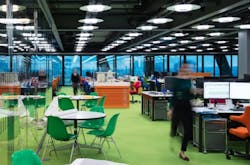Its new Light over Time for touch panels can alter color temperatures and brightness to suit different people and activities.
Finnish LED lighting company Helvar has added another piece to its repertoire of smart lighting technology, introducing touch-screen software that lets offices change the interior lighting's color temperature and brightness to suit different tasks and objectives.
Interested in more articles about human-centric lighting & smart lighting applications?
The new Light over Time software delivers what is commonly known as human-centric (HCL), or circadian, lighting. As LEDs Magazine noted in a recent two-part feature, colder blue-hued light can foster alertness, and warmer amber hues can set a more relaxing atmosphere.
While scientists and engineers continue to debate and research HCL's exact effectiveness, lighting vendors like Helvar and others are subscribing to its general principles of boosting wellbeing, concentration and alertness. Light over Time is Helvar's latest addition to its HCL line that it calls Intelligent Colour.
Learn more about human-centric lighting and how light promotes health and productivity at the 2017 Lighting for Health and Wellbeing conference July 27! Meet us in Newport Beach, CA: lightingforhealthandwellbeing.com
“We believe that the creation and implementation of customizable lighting profiles in tune with people’s circadian rhythm will provide a real benefit,” said Helvar product manager Thet Oo. “Dynamic tunable white solutions like Helvar’s Light over Time provide a great opportunity to aid with people’s wellbeing.”
The software is aimed at lighting designers and specifiers, as well at end users.
Helvar claims that human-centric lighting (HCL) boosts performance and comfort at the London offices of architects Rogers Stirk Harbour + Partners. (Photo credit: Helvar.)
“Light over Time offers complete flexibility in how the lighting is programmed,” Helvar said. “For example, in an office environment the lighting designer may want to keep the lighting cool in the morning and early afternoon with an interval of warm light in the middle of the day, so that staff feel more comfortable while taking a lunch break. This can be achieved simply and effectively using the intuitive graphical interface to create the lighting profile.”
To help determine the right lighting profile for a certain situation or group, the software can factor in many variables including activity, location, and peoples' ages. Helvar said Light over Time is suitable not only for commercial offices but also for educational and healthcare settings
In an early implementation of the human-centric lighting concept, Helvar has outfitted the offices of architects Rogers Stirk Harbour + Partners with a showcase HCL system, as LEDs sister publication Lux wrote last year. That system, in London's three-year-old “Cheesegrater” skyscraper, uses a combination of touch-screen software, sensors, ceiling detectors, and an IT router. Helvar claims that it boosts performance and comfort.
Human-centric lighting is part of the Internet of Things (IoT) movement that is increasingly driving the lighting industry. Helvar has been steadily fortifying its IoT program. In partnership with Finland's Oulu University, the company is currently trialing wireless lighting controls that work over a 5G cellular network at university facilities. LEDs hopes to write more about that project.
With the IoT clearly in its sights, Helvar has over the last year hired several executives with information technology backgrounds, including CEO Hans Henrik Lund. He joined last September after serving in executive roles with mobile phone headset and accessory companies Nokia Gear and Jabra, and with Danfoss, the Danish company that sells products and services in air conditioning, heating, building automation, motor controls, compressors, and other areas.
MARK HALPERis a contributing editor for LEDs Magazine, and an energy, technology, and business journalist ([email protected]).

Mark Halper | Contributing Editor, LEDs Magazine, and Business/Energy/Technology Journalist
Mark Halper is a freelance business, technology, and science journalist who covers everything from media moguls to subatomic particles. Halper has written from locations around the world for TIME Magazine, Fortune, Forbes, the New York Times, the Financial Times, the Guardian, CBS, Wired, and many others. A US citizen living in Britain, he cut his journalism teeth cutting and pasting copy for an English-language daily newspaper in Mexico City. Halper has a BA in history from Cornell University.





